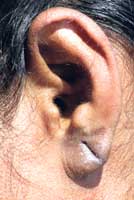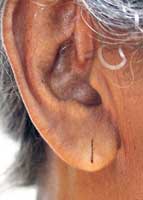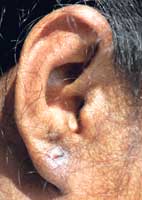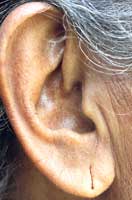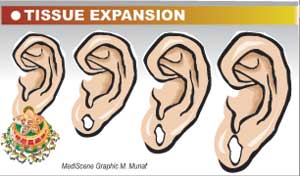
All that glitters is not healthyAround 18% of women around the world fall victim to slit ear lobes. But do you know what causes this? A slit where the hole should be or moist scaly skin in an otherwise unblemished face. Beautiful faces but marred ear lobes. Heavy jewellery, everyone assumes. Wrong, says Reconstructive Surgeon Dr. Lalantha Amarasinghe, dispelling a popular myth believed by most people. Slit ear lobes have nothing to do with the weight of the jewellery, stresses Dr. Amarasinghe, explaining that a shocking 18% of women all over the world including Sri Lanka but excluding Nepal are victims of this. The prevalence figures come out from a rare but major research conducted by Dr. Subodhini Ravindran, who peered at numerous ear lobes of women in this country and abroad, on a "suspicion" of Dr. Amarasinghe of what the causes may be. The research findings have been accepted and published in the British Journal of Plastic Surgery. The condition of slit ear lobes can affect anyone who wears earrings between the age of two years, around the time a little one's ears are bored, and up to 85 years, MediScene learns. How do slit ear lobes occur? The explanation is that it is the reaction of the ear lobe to an alloy of metals contained in the bar or stem of gold earrings that are passed through the pierced ears. Going into intricate detail, Dr. Amarasinghe says that even in a 24-carat gold earring, as the bar has to have grooves cut into it to make the rear gold ball fit tightly, jewellers use an alloy of copper, nickel, iron and lead as gold alone is too malleable.
"The amount of copper, nickel, iron and lead may be microscopic and the gold 95% but the wearer may react especially to the nickel," he explains. In such situations, three things can happen. With the ear-lobe reacting to the alloy, there is erosion of the skin but the ear lobe does not expand. Add to this the pull of gravity or downward pull and the hole becomes a slit, MediScene understands. If nothing is done, says Dr. Amarasinghe, the slit becomes longer and longer and finally the ear lobe splits into two in a condition called bifid ear lobe. Another reaction could come in the form of a "frank eczema", according to him, with a moist discharge and a rash around the hole on the ear lobe. This could also result in the person being more prone to allergies to pineapple, seafood etc and rashes erupting in other parts of the body. However, Dr. Amarasinghe says the more "frightening" third reaction could be the contact point or the hole in the ear lobe starting a hyper-trophic response in the form of a keloid mass or tumour. "The treatment for this is the surgical removal of the tumour but if the person goes back to wearing the same earrings triggering another tumour, the ear lobe would get gradually smaller and smaller," he says, disfiguring the person. The slit does not occur in both ears at the same time but in one ear first and affects the other about four to five years later. The surgical repair of a slit ear lobe is easy, MediScene learns, with the Surgeon cutting off the affected part of the skin and stitching it together. But, warns Dr. Amarasinghe, if the ear lobe is bored again, earrings with stems made of an alloy should never be worn to prevent a recurrence. "The surgery is easy and painless but is not the final solution." Another important point to remember is that if the slit takes six years to develop in the first instance and after repair, the person continues to use the same earrings, it will recur in double quick time, that’s in three years, says Dr. Amarasinghe, adding that most patients will label the first surgeon as inefficient and go to another seeking re-repair of the ear lobe. Changing surgeons won’t help but not wearing the same earrings will, he says. Of course, the simple answer to slit ear lobes will be to avoid earrings altogether, smiles Dr. Amarasinghe, conceding however that it is near-impossible for most women to do so. Giving a very temporary solution, he advises women to apply a little colourless cutex or nail polish on the stem just before wearing the earrings to prevent contact with the skin. "But that will last only for an evening," he says. The other suggestions are that the stem could be made of silver with a slight copper mix or even platinum, which he however says is prohibitively expensive. Clip-ons made of steel sans nickel may be a more permanent option, MediScene learns, while gypsy earrings are known not to have an alloy because they do not have stems. Tissue Expansion
There are no slit ear lobes in Nepal, maybe the only country in the world, says Dr. Amarasinghe, because though the women wear lots of gold jewellery, they use thick blocks of rubber stuck to a pointed earring stem to keep it in place, instead of a grooved stem. Meanwhile, ever wondered why the women, mostly on estates, have large holes instead of tiny points on their ear lobes. "This is due to heavy jewellery which causes gradual tissue expansion, but the surrounding tissue is healthy," adds Dr. Amarasinghe. |
|||||||||
|
||||||
|| Front
Page | News | Editorial | Columns | Sports | Plus | Financial
Times | International | Mirror | TV
Times | Funday
Times | Medi Scene || |
| |
Reproduction of articles permitted when used without any alterations to contents and the source. |
© Copyright
2008 | Wijeya
Newspapers Ltd.Colombo. Sri Lanka. All Rights Reserved. |
